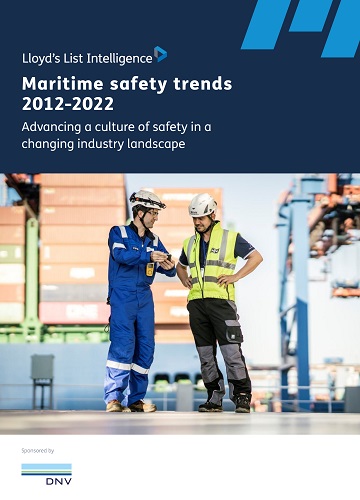Doubling of machinery failures since 2012 leads casualty trend analysis
Incident paths must be better understood if shipping is to successfully embrace the uncertainties of new fuels and technologies, recommends a new maritime safety report from DNV and Lloyd’s List Intelligence
The report, subtitled ‘Advancing a culture of safety in a changing industry landscape’, advocates the creation of a safety practice that flows from the senior leadership team throughout the business
A STEADY rise in the number of machinery damage or failure incidents in the decade between 2012 and 2022 is the main finding of a new survey of maritime casualties conducted by Lloyd’s List Intelligence and DNV.
More than 700 ships reported machinery breakdowns at the beginning of the period, rising to almost 1,000 in 2015 and 1,500 in 2022. These involved all vessel types and sizes, with general cargoships, bulk carriers and ferries particularly being affected.
At the same time, there were significant falls in the number of incidents involving collision with other ships, fires, piracy and foundering.
A second trend picked out by the casualty analysis is the encouraging decline in the number of incidents for the years between 2015 and 2020. However, the subsequent increase in incidents during the pandemic years and in the past year of conflict between Russia and Ukraine suggests more needs to be done to understand why accidents happen and where further research should be targeted.
This survey covers the period before the full effects of decarbonisation are clear for shipping.
In his foreword to the Maritime Safety Trends report, DNV Maritime chief executive Knut Ørbeck-Nilssen observes that demand for a more decarbonised world and rapid technological advancements are “compelling us to calibrate our way of thinking about safety”.
He adds: “New engine types, fuels, and digital systems offer many solutions but also bring increased
uncertainty and new risks. The maritime industry needs to embrace safety as it adapts to these changes.”
Companies must develop a robust and trustworthy safety culture, Ørbeck-Nilssen urges, a culture that places people at its core.
There are several elements to this culture, which interact with one another, support and affirm when necessary, and warn of gaps when they appear. This report, subtitled ‘Advancing a culture of safety in a changing industry landscape’, advocates the creation of a safety culture that flows from the senior leadership team down through all layers of the business onshore and at sea, and then back to the chief executive.
It concludes that shipping must share safety experience if the 80% of incidents attributed to human error is to be seriously addressed.
Valuable contributions to the report come from DNV department safety advisory head Øystein Goksøyr who believes change management is critical if the industry is to successfully implement a transformation to smart shipping; from DNV safety regulation expert Kathrine Ilje Nerland who stresses that rules and guidelines must keep up with technological advancements to keep shipping safe; and from the Mission to Seafarers secretary-general Rev Canon Andrew Wright who comments that the work of the maritime welfare sector, in its diversity of approaches, is at the core of sustaining well-being, and consequently safety, among crews.
This report makes a clear case for the industry to pull together at a time of change and transformation, and to look beyond the competitive edge to a safe, secure and sustainable industry. There is nothing inevitable about human error, at any stage of the maritime venture, and no reason why shipping’s transition to an era of decarbonisation should put safety second.
In the words of DNV’s chief executive, “nothing will ever be more important than the safety of our people, vessels, and the environment”.




